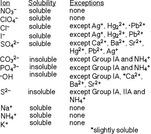
This module includes solubility rules, how to use the solubility rules, calculating moles of ions from grams of compound, and how to write Net Ionic Equations.

This module includes solubility rules, how to use the solubility rules, calculating moles of ions from grams of compound, and how to write Net Ionic Equations.
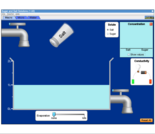
This chemistry activity was created to enhance student learning around solutions. It guides students through Phet simulations and then asks comprehension questions thereafter.
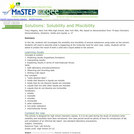
This is a lab activity where students will investigate solubility or miscibility of eight substances with water.
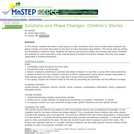
This activity is a small-group activity that makes students learn the subject matter of aqueous solutions (colloids, suspensions) and phase changes by writing a children's book. Learning by teaching.
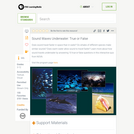
This interactive quiz from the NOVA Web site features an array of interesting facts about the nature of sound underwater.

This video segment, adapted from ZOOM, explores how sound waves travel differently through solids than through air, in this case, a metal clothes hanger.

The mission of Southwest Research and Information Center is to promote the health of people and communities, protect natural resources, ensure citizen participation, and secure environmental and social justice now and for future generations. The Uranium Impact Assessment Program contains information about current issues dealing with the Navajo Nation. Useful fact sheets are found on this site.

This is a lesson about using light to identify the composition of an object. Learners will use a spectrograph to gather data about light sources. Using the data they’ve collected, students are able to make comparisons between different light sources and make conjectures about the composition of a mystery light source. The activity is part of Project Spectra, a science and engineering program for middle-high school students, focusing on how light is used to explore the Solar System.

What happens when an excited atom emits a photon? What can we deduce about that atom based on the photons it can emit? A series of interactive models allows you to examine how the energy levels the electrons of an atom occupy affect the types of photons that can be emitted. Use a digital spectrometer to record which wavelengths certain atoms will emit, and then use this knowledge to compare and identify types of atoms. Students will be abe to:
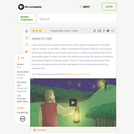
This video segment adapted from Shedding Light on Science uses historical illustrations and everyday examples to show that light has a speed and does not travel instantaneously.
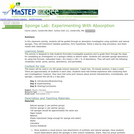
This activity allows students to brainstorm investigable questions, conduct an experiment, and communicate the results related to our invertebrate animal study; specifically sponges and absorption. (Lesson is based on an original activity from "Porifera's Porosity", Holt Science and Technology - Animals, Holt, Rinehart, and Winston 2002, pages 50-51.)
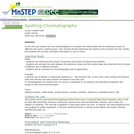
In this mini-lab students will use chromatography to compare the mobile phase and the stationary phases of different inks used in marking pens. They will also determine the polarity of the solvents and inks. Finally, the students will use their calculated information to solve a crime.
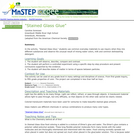
This activity is an investigation where students explore the properties of color and light, using mixtures of common everyday materials.
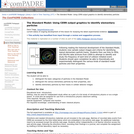
After using the historical development of the Standard Model to develop introductory understanding, students link to OPAL and DELPHI data archives from CERN to identify and study the tracks from elementary particles.

This activity is used to introduce the different properties of states of matter, by testing an unknown substance with household materials to determine which state of matter most closely resembles the material. It also can invole data collection, reasoning, grph making, and presentation of findings.
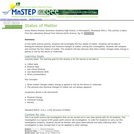
This activity is a lab investigation where students observe the four states of matter. At the end of the investigation students should be able to know that the differences among the physical states depend on the distance between the atoms or molecules and on the rate of movement of the atoms or molecules. And, that pressure and temperature control these two factors.
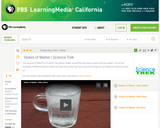
This video segment from IdahoPTV's D4K explains and gives examples of the 4 states of matter: solid, liquid, gas, and plasma.

Watch different types of molecules form a solid, liquid, or gas. Add or remove heat and watch the phase change. Change the temperature or volume of a container and see a pressure-temperature diagram respond in real time. Relate the interaction potential to the forces between molecules.
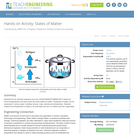
Students act as chemical engineers and use LEGO® MINDSTORMS® NXT robotics to record temperatures and learn about the three states of matter. Properties of matter can be measured in various ways, including volume, mass, density and temperature. Students measure the temperature of water in its solid state (ice) as it is melted and then evaporated.
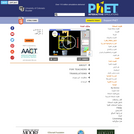
Watch different types of molecules form a solid, liquid, or gas. Add or remove heat and watch the phase change. Change the temperature or volume of a container and see a pressure-temperature diagram respond in real time. Relate the interaction potential to the forces between molecules.